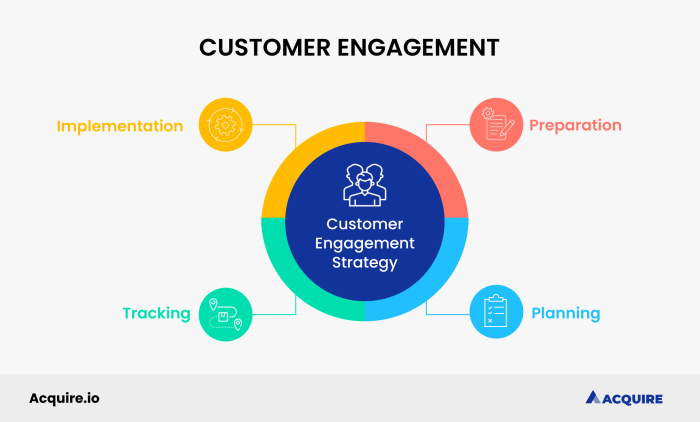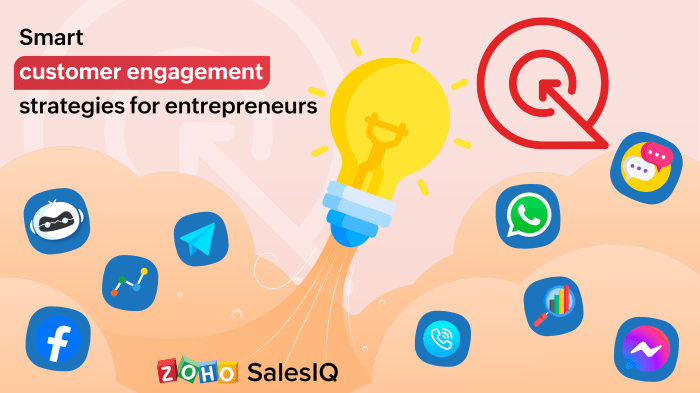Developing a Customer Engagement Strategy takes center stage, inviting readers into a world of business mastery. Get ready to dive into the art of engaging customers like never before.
In this comprehensive guide, we’ll explore the key elements of customer engagement and how businesses can craft strategies that resonate with their target audience.
Understanding Customer Engagement
Customer engagement in a business context refers to the interactions and relationships a company builds with its customers. It involves creating meaningful connections, fostering loyalty, and encouraging repeat business.
Developing a customer engagement strategy is crucial for businesses as it helps in understanding customer needs, improving customer satisfaction, and building long-lasting relationships. By actively engaging with customers, companies can gather valuable feedback, enhance brand reputation, and increase customer retention.
Examples of Successful Customer Engagement Strategies
- Starbucks: Starbucks has successfully engaged customers through their loyalty program, personalized promotions, and interactive mobile app. They use customer data to offer personalized recommendations and create a seamless shopping experience.
- Apple: Apple has built a strong customer engagement strategy through their user-friendly products, exceptional customer service, and community-building initiatives like Apple stores and online forums. They focus on creating a sense of belonging and loyalty among their customers.
- Nike: Nike engages customers through their Nike+ app, exclusive product launches, and partnerships with athletes and influencers. They create interactive experiences, encourage user-generated content, and build a community around their brand.
Researching Your Target Audience

Understanding your target audience is crucial for creating an effective customer engagement strategy. By conducting research on your target audience, you can tailor your marketing efforts to meet their specific needs and preferences, ultimately leading to better engagement and customer satisfaction.
Methods for Conducting Audience Research
- Surveys: Create and distribute surveys to gather information about your target audience’s demographics, interests, and purchasing behaviors.
- Interviews: Conduct one-on-one interviews with existing customers to delve deeper into their motivations and preferences.
- Focus Groups: Bring together a small group of individuals from your target audience to discuss and provide feedback on your products or services.
- Social Media Listening: Monitor conversations on social media platforms to understand what your target audience is talking about and how they feel about your brand.
Using Data Analytics to Gain Insights
Data analytics plays a crucial role in understanding your target audience on a deeper level. By analyzing data such as website traffic, social media engagement, and purchase history, businesses can gain valuable insights into their audience’s behavior and preferences. This data can help businesses personalize their marketing efforts, improve customer segmentation, and optimize their overall customer engagement strategy.
Creating Personalized Experiences: Developing A Customer Engagement Strategy
Personalizing customer experiences in a customer engagement strategy can lead to increased customer loyalty, higher conversion rates, and improved customer satisfaction. By tailoring interactions based on individual preferences and behaviors, businesses can create a more meaningful connection with their customers.
Benefits of Personalization
Personalizing customer experiences can result in:
- Increased customer loyalty and retention
- Higher customer satisfaction levels
- Improved customer engagement and brand loyalty
Collecting Data for Personalization
Ways to collect data for personalization without compromising customer privacy include:
- Utilizing first-party data from customer interactions and transactions
- Implementing transparent privacy policies and obtaining explicit consent for data collection
- Using anonymized data for analysis and personalization
Examples of Companies Providing Personalized Experiences
Some companies that have excelled in providing personalized experiences to their customers include:
- Amazon: Utilizes purchase history and browsing behavior to recommend personalized products
- Netflix: Recommends movies and TV shows based on viewing history and preferences
- Spotify: Creates customized playlists based on listening habits and music preferences
Utilizing Multiple Communication Channels

In today’s digital age, utilizing multiple communication channels is crucial for businesses to effectively engage with their customers. By diversifying the channels through which you interact with your audience, you can reach them where they are most comfortable and increase the chances of building strong relationships.
Importance of Using Various Communication Channels
Utilizing various communication channels allows businesses to meet customers at different touchpoints, providing a seamless and cohesive experience. This approach caters to different preferences and behaviors, enhancing customer satisfaction and loyalty.
- Social Media: Platforms like Facebook, Instagram, Twitter, and LinkedIn offer direct and interactive ways to engage with customers, share updates, and address concerns.
- Email: Email marketing remains a powerful tool for personalized communication, delivering targeted messages and promotions to customers’ inboxes.
- Live Chat: Providing instant support through live chat on websites can improve customer experience by resolving queries in real-time.
- SMS: Sending text messages can be an effective way to deliver quick updates, reminders, or promotions directly to customers’ phones.
Best Practices for Integrating Communication Channels, Developing a Customer Engagement Strategy
Integrating multiple communication channels requires a strategic approach to ensure consistency and effectiveness. Here are some best practices to consider:
- Unified Messaging: Maintain a consistent brand voice and messaging across all channels to reinforce your brand identity.
- Omnichannel Strategy: Seamlessly integrate different channels to provide a unified customer experience, allowing customers to switch between channels without losing context.
- Data Analytics: Utilize data analytics to track customer interactions across channels and optimize your engagement strategy based on insights.
- Personalization: Tailor communication based on customer preferences and behavior to create personalized experiences that resonate with your audience.
Implementing Feedback Mechanisms
Feedback plays a crucial role in refining and improving a customer engagement strategy. It provides valuable insights into customer preferences, satisfaction levels, and areas for improvement. By implementing effective feedback mechanisms, businesses can enhance customer engagement and build stronger relationships with their target audience.
Gathering Feedback from Customers
- Surveys: Create and distribute online surveys to collect feedback on various aspects of the customer experience, such as product satisfaction, service quality, and overall brand perception.
- Reviews: Encourage customers to leave reviews on platforms like Google, Yelp, or social media channels to gather feedback on specific products or services.
- Social Media Comments: Monitor and analyze comments, mentions, and direct messages on social media platforms to understand customer sentiment and address any concerns promptly.
Analyzing and Acting Upon Feedback
- Identify Patterns: Look for common themes or trends in the feedback received to pinpoint areas that require immediate attention or improvement.
- Prioritize Action Items: Determine which feedback requires urgent action and prioritize initiatives to address customer concerns effectively.
- Implement Changes: Use customer feedback to make informed decisions and implement changes that enhance the overall customer experience, such as product enhancements, service improvements, or communication adjustments.












